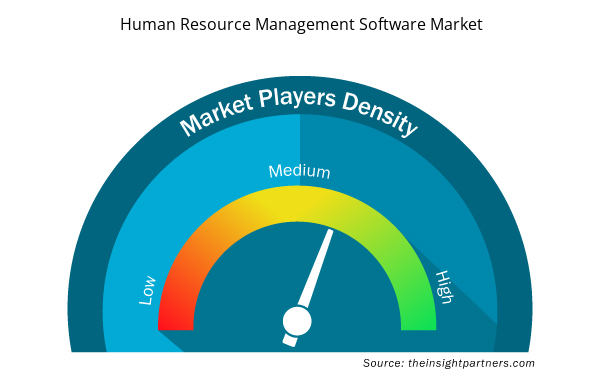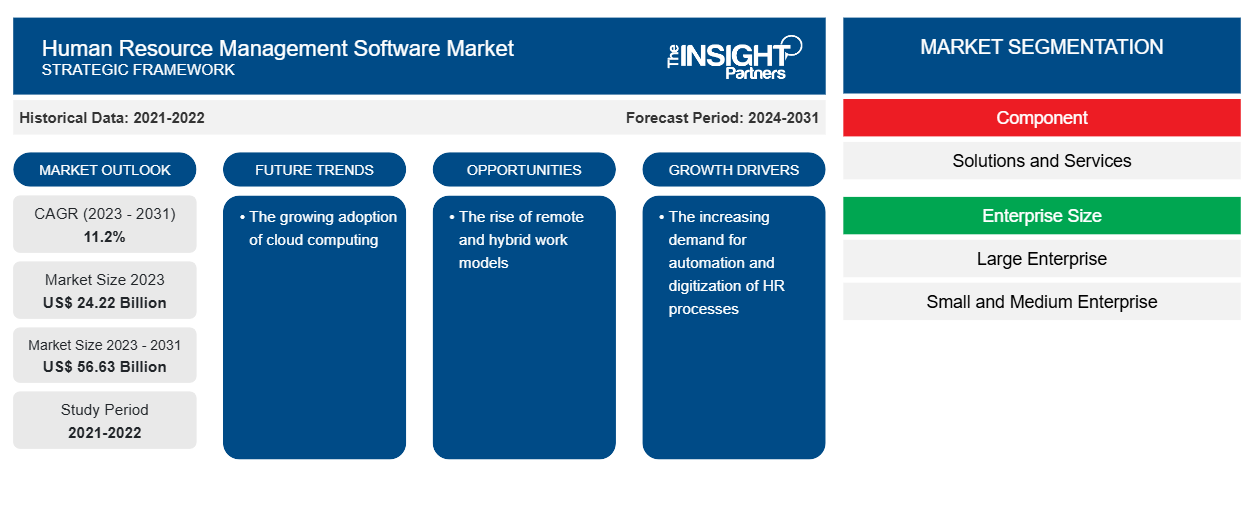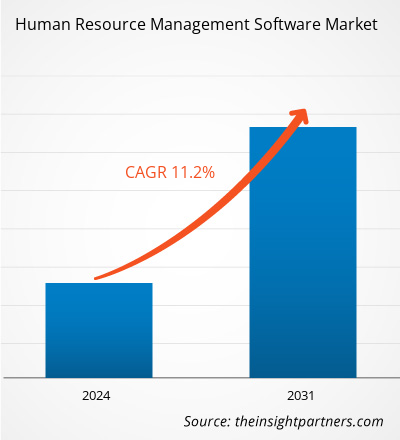人事管理ソフトウェアの市場規模は、2023 年の 242.2 億米ドルから 2031 年には 566.3 億米ドルに達すると予測されています。市場は 2023 年から 2031 年にかけて 11.2 % の CAGR を記録すると予想されています。クラウド コンピューティングの採用の増加は、人事管理ソフトウェア市場の主要なトレンドであり続けると思われます。
人事管理ソフトウェア市場分析
人材管理のための AI 駆動型分析、クラウドベースの HRMS の台頭、リモート ワーカー向けのモバイル対応プラットフォームなど、人事市場にはいくつかの重要なトレンドがあります。市場は、ユーザー エクスペリエンスと熾烈な競争、統合機能、データ セキュリティに重点を置いて分類されています。組織が従業員の生産性とエンゲージメントを優先するにつれて、HRMS 市場は世界中で拡大し続けると予測されています。
人事管理ソフトウェア市場の概要
人事管理 (HRM) ソフトウェアは、従業員管理の効率と有効性を高めるために、いくつかの HR 機能を最新化します。これらのプラットフォームには通常、給与処理、出勤状況の追跡、パフォーマンス管理、採用、オンボーディング、従業員セルフサービス用のモジュールが含まれています。また、HRM ソフトウェアは、労働法や規制への準拠を容易にします。HRM ソフトウェアによく見られる主な機能には、従業員データから洞察を引き出し、意思決定を支援する強力なレポート機能と分析機能があります。多くのプラットフォームは、リモート アクセスと拡張性を可能にするクラウド ベースのソリューションを提供しています。人気の高い HRM ソフトウェア プロバイダーには、Workday、ADP、BambooHR、SAP SuccessFactors などがあり、それぞれがさまざまな規模や業界の企業に合わせてカスタマイズされたソリューションを提供しています。HRM ソフトウェアを実装すると、従業員のエンゲージメントが向上し、管理上の負担が軽減され、HR 業務が合理化されます。ただし、適切なソフトウェアを選択するには、拡張性、既存のシステムとの統合機能、ユーザー エクスペリエンスなどの要素を考慮する必要があります。
要件に合わせてレポートをカスタマイズする
このレポートの一部、国レベルの分析、Excelデータパックなど、あらゆるレポートを無料でカスタマイズできます。また、スタートアップや大学向けのお得なオファーや割引もご利用いただけます。
- このレポートの主要な市場動向を入手してください。この無料サンプルには、市場動向から見積もりや予測に至るまでのデータ分析が含まれます。
人事管理ソフトウェア市場の推進要因と機会
人事プロセスの自動化とデジタル化の需要の高まり
組織が業務の合理化と効率性の向上を目指す中、HRM ソフトウェアは給与管理、従業員エンゲージメント、業績評価、人材獲得のためのソリューションを提供します。戦略的な意思決定をサポートするための集中的なデータ管理と分析の必要性も、HRM ソフトウェアの導入を促進しています。
リモートワークとハイブリッドワークモデルの台頭
柔軟な勤務形態への移行に伴い、組織はリモート ワークフォースの管理、コラボレーション、コミュニケーションを促進する HRM ツールを必要としています。HRM ソフトウェアは、シームレスなリモート オンボーディング、仮想トレーニング、従業員エンゲージメント イニシアチブを可能にします。企業が新しい仕事のパラダイムに適応するにつれて、HRM ソフトウェア プロバイダーは革新の機会を得て、分散チームの進化するニーズに対応するソリューションを提供し、生産性と従業員の満足度を向上させることができます。したがって、リモートおよびハイブリッド ワーク モデルの台頭により、予測期間中に人事管理ソフトウェア市場のプレーヤーに新たな機会がもたらされると予想されます。
人事管理ソフトウェア市場レポートのセグメンテーション分析
人事管理ソフトウェア市場分析の導出に貢献した主要なセグメントは、コンポーネント、企業規模、およびエンドユーザーです。
- コンポーネントに基づいて、人事管理ソフトウェア市場はソリューションとサービスに分類されます。
- 企業規模別に見ると、市場は大企業、中小企業に分類されます。大企業セグメントは2023年に大きな市場シェアを占めました。
- エンドユーザー別に見ると、市場は教育機関、BFSI、政府、医療、ITおよび通信、製造、小売、その他に分類されます。
地域別人事管理ソフトウェア市場シェア分析
人材管理ソフトウェア市場レポートの地理的範囲は、主に北米、アジア太平洋、ヨーロッパ、中東およびアフリカ、南米/中南米の 5 つの地域に分かれています。収益の面では、北米が人材管理ソフトウェア市場で最大のシェアを占めています。北米、特に米国とカナダでは、大企業が人材獲得、給与管理、従業員エンゲージメントのために統合 HRM スイートを採用したことで、堅調な成長が促進されています。
人事管理ソフトウェア市場の地域別分析
予測期間を通じて人材管理ソフトウェア市場に影響を与える地域的な傾向と要因は、Insight Partners のアナリストによって徹底的に説明されています。このセクションでは、北米、ヨーロッパ、アジア太平洋、中東およびアフリカ、南米および中米にわたる人材管理ソフトウェア市場のセグメントと地理についても説明します。

- 人事管理ソフトウェア市場の地域別データを入手
人事管理ソフトウェア市場レポートの範囲
| レポート属性 | 詳細 |
|---|---|
| 2023年の市場規模 | 242.2億米ドル |
| 2031年までの市場規模 | 566.3億米ドル |
| 世界のCAGR(2023年~2031年) | 11.2% |
| 履歴データ | 2021-2022 |
| 予測期間 | 2024-2031 |
| 対象セグメント | コンポーネント別
|
| 対象地域と国 | 北米
|
| 市場リーダーと主要企業プロフィール |
|
人事管理ソフトウェア市場のプレーヤー密度: ビジネスダイナミクスへの影響を理解する
人事管理ソフトウェア市場は、消費者の嗜好の変化、技術の進歩、製品の利点に対する認識の高まりなどの要因により、エンドユーザーの需要が高まり、急速に成長しています。需要が高まるにつれて、企業は提供内容を拡大し、消費者のニーズを満たすために革新し、新たなトレンドを活用し、市場の成長をさらに促進しています。
市場プレーヤー密度とは、特定の市場または業界内で活動している企業または会社の分布を指します。これは、特定の市場スペースに、その規模または総市場価値と比較して、どれだけの競合相手 (市場プレーヤー) が存在するかを示します。
人事管理ソフトウェア市場で事業を展開している主要企業は次のとおりです。
- オートマチック データ プロセッシング株式会社
- SAP SE
- オラクル株式会社
- ワークデイ株式会社
- セリディアンHCMホールディングス
- セザンヌHRリミテッド
免責事項:上記の企業は、特定の順序でランク付けされていません。

- 人事管理ソフトウェア市場のトップキープレーヤーの概要を入手
人事管理ソフトウェア市場のニュースと最近の動向
人事管理ソフトウェア市場は、主要な企業出版物、協会データ、データベースなどの一次調査と二次調査後の定性的および定量的データを収集することで評価されます。以下は、音声言語障害と戦略の市場における動向の一覧です。
- 2023年4月、Pocket HRMSは、インドの中小企業が、インド各地の言語でWhatsAppメッセージングプラットフォームを介して直感的で使いやすいHRソフトウェアを使用して、HRMS、給与計算システム、および関連するコンプライアンス全体をデジタル化できるようにするというミッション「Bharat 2.0」の開始を発表しました。(出典:Pocket HRMS、プレスリリース)
- 2024 年 1 月、人事管理ソリューションの大手プロバイダーである OrangeHRM は、同社の高度なバージョンに画期的な追加機能として AI 対応ヘルプデスクを導入すると発表しました。HRM ヘルプ ポータルからアクセスできるこの革新的な機能は、ユーザー エクスペリエンスを向上させるために人工知能を活用するという OrangeHRM の取り組みにおいて重要なマイルストーンとなります。(出典: OrangeHRM、プレス リリース)
人事管理ソフトウェア市場レポートの対象範囲と成果物
「人事管理ソフトウェア市場の規模と予測(2023〜2031年)」レポートでは、以下の分野をカバーする市場の詳細な分析を提供しています。
- 対象範囲に含まれるすべての主要市場セグメントの世界、地域、国レベルでの市場規模と予測
- 市場の動向(推進要因、制約、主要な機会など)
- 今後の主な動向
- 詳細なPEST/ポーターの5つの力とSWOT分析
- 主要な市場動向、主要プレーヤー、規制、最近の市場動向を網羅した世界および地域の市場分析
- 市場集中、ヒートマップ分析、主要プレーヤー、最近の動向を網羅した業界の状況と競争分析
- 詳細な企業プロフィール
- 過去2年間の分析、基準年、CAGRによる予測(7年間)
- PEST分析とSWOT分析
- 市場規模価値/数量 - 世界、地域、国
- 業界と競争環境
- Excel データセット



Report Coverage
Revenue forecast, Company Analysis, Industry landscape, Growth factors, and Trends

Segment Covered
This text is related
to segments covered.

Regional Scope
North America, Europe, Asia Pacific, Middle East & Africa, South & Central America

Country Scope
This text is related
to country scope.
よくある質問
The global human resource management software market is expected to reach US$ 56.63 billion by 2031.
The growing adoption of cloud computing is anticipated to play a significant role in the global human resource management software market in the coming years.
The key players holding majority shares in the global human resource management software market are Automatic Data Processing, Inc., SAP SE, Oracle Corporation, Workday, Inc., and Ceridian HCM Holding Inc.
The global human resource management software market was estimated to be US$ 24.22 billion in 2023 and is expected to grow at a CAGR of 11.2 % during the forecast period 2023 - 2031.
The increasing demand for automation and digitization of HR processes and the rise of remote and hybrid work models are the major factors that propel the global human resource management software market.
Trends and growth analysis reports related to Technology, Media and Telecommunications : READ MORE..
The Insight Partners performs research in 4 major stages: Data Collection & Secondary Research, Primary Research, Data Analysis and Data Triangulation & Final Review.
- Data Collection and Secondary Research:
As a market research and consulting firm operating from a decade, we have published and advised several client across the globe. First step for any study will start with an assessment of currently available data and insights from existing reports. Further, historical and current market information is collected from Investor Presentations, Annual Reports, SEC Filings, etc., and other information related to company’s performance and market positioning are gathered from Paid Databases (Factiva, Hoovers, and Reuters) and various other publications available in public domain.
Several associations trade associates, technical forums, institutes, societies and organization are accessed to gain technical as well as market related insights through their publications such as research papers, blogs and press releases related to the studies are referred to get cues about the market. Further, white papers, journals, magazines, and other news articles published in last 3 years are scrutinized and analyzed to understand the current market trends.
- Primary Research:
The primarily interview analysis comprise of data obtained from industry participants interview and answers to survey questions gathered by in-house primary team.
For primary research, interviews are conducted with industry experts/CEOs/Marketing Managers/VPs/Subject Matter Experts from both demand and supply side to get a 360-degree view of the market. The primary team conducts several interviews based on the complexity of the markets to understand the various market trends and dynamics which makes research more credible and precise.
A typical research interview fulfils the following functions:
- Provides first-hand information on the market size, market trends, growth trends, competitive landscape, and outlook
- Validates and strengthens in-house secondary research findings
- Develops the analysis team’s expertise and market understanding
Primary research involves email interactions and telephone interviews for each market, category, segment, and sub-segment across geographies. The participants who typically take part in such a process include, but are not limited to:
- Industry participants: VPs, business development managers, market intelligence managers and national sales managers
- Outside experts: Valuation experts, research analysts and key opinion leaders specializing in the electronics and semiconductor industry.
Below is the breakup of our primary respondents by company, designation, and region:

Once we receive the confirmation from primary research sources or primary respondents, we finalize the base year market estimation and forecast the data as per the macroeconomic and microeconomic factors assessed during data collection.
- Data Analysis:
Once data is validated through both secondary as well as primary respondents, we finalize the market estimations by hypothesis formulation and factor analysis at regional and country level.
- Macro-Economic Factor Analysis:
We analyse macroeconomic indicators such the gross domestic product (GDP), increase in the demand for goods and services across industries, technological advancement, regional economic growth, governmental policies, the influence of COVID-19, PEST analysis, and other aspects. This analysis aids in setting benchmarks for various nations/regions and approximating market splits. Additionally, the general trend of the aforementioned components aid in determining the market's development possibilities.
- Country Level Data:
Various factors that are especially aligned to the country are taken into account to determine the market size for a certain area and country, including the presence of vendors, such as headquarters and offices, the country's GDP, demand patterns, and industry growth. To comprehend the market dynamics for the nation, a number of growth variables, inhibitors, application areas, and current market trends are researched. The aforementioned elements aid in determining the country's overall market's growth potential.
- Company Profile:
The “Table of Contents” is formulated by listing and analyzing more than 25 - 30 companies operating in the market ecosystem across geographies. However, we profile only 10 companies as a standard practice in our syndicate reports. These 10 companies comprise leading, emerging, and regional players. Nonetheless, our analysis is not restricted to the 10 listed companies, we also analyze other companies present in the market to develop a holistic view and understand the prevailing trends. The “Company Profiles” section in the report covers key facts, business description, products & services, financial information, SWOT analysis, and key developments. The financial information presented is extracted from the annual reports and official documents of the publicly listed companies. Upon collecting the information for the sections of respective companies, we verify them via various primary sources and then compile the data in respective company profiles. The company level information helps us in deriving the base number as well as in forecasting the market size.
- Developing Base Number:
Aggregation of sales statistics (2020-2022) and macro-economic factor, and other secondary and primary research insights are utilized to arrive at base number and related market shares for 2022. The data gaps are identified in this step and relevant market data is analyzed, collected from paid primary interviews or databases. On finalizing the base year market size, forecasts are developed on the basis of macro-economic, industry and market growth factors and company level analysis.
- Data Triangulation and Final Review:
The market findings and base year market size calculations are validated from supply as well as demand side. Demand side validations are based on macro-economic factor analysis and benchmarks for respective regions and countries. In case of supply side validations, revenues of major companies are estimated (in case not available) based on industry benchmark, approximate number of employees, product portfolio, and primary interviews revenues are gathered. Further revenue from target product/service segment is assessed to avoid overshooting of market statistics. In case of heavy deviations between supply and demand side values, all thes steps are repeated to achieve synchronization.
We follow an iterative model, wherein we share our research findings with Subject Matter Experts (SME’s) and Key Opinion Leaders (KOLs) until consensus view of the market is not formulated – this model negates any drastic deviation in the opinions of experts. Only validated and universally acceptable research findings are quoted in our reports.
We have important check points that we use to validate our research findings – which we call – data triangulation, where we validate the information, we generate from secondary sources with primary interviews and then we re-validate with our internal data bases and Subject matter experts. This comprehensive model enables us to deliver high quality, reliable data in shortest possible time.


 このレポートの無料サンプルを入手する
このレポートの無料サンプルを入手する